[EDIT: you can read the stories from my progress across my map here.]
The first faint frost as I headed out this morning. The first morning in gloves. The first fieldfares flying urgently over the fields, those winter thrushes with their alternating flights of several wing beats then a quick glide, eager to forage on the red hawthorn berries that are in abundance right now. Fieldfares are the sort of birds that I never would have noticed before I began consciously trying to pay attention to the local nature all around me.
Fieldfares are large, colourful thrushes, much like a mistle thrush in general size, shape and behaviour. They stand very upright and move forward with purposeful hops. They are very social birds, spending the winter in flocks of anything from a dozen or two to several hundred strong. These straggling, chuckling flocks which roam the UK’s countryside are a delightful and attractive part of the winter scene. Fieldfares are best looked for in the countryside, along hedges and in fields. Hawthorn hedges with berries are a favourite feeding area. In late winter grass fields, playing fields and arable fields with nearby trees and hedges are a favourite place.
Reading about fieldfares led me to discover a Twitter rabbit hole via the #vismig hashtag (which I’d never heard of). Visible migration (which I’d never heard of) is the “visible” migration of birds (and butterflies) whose diurnal migratory flights can be observed directly. Many birds are nocturnal migrants, such as warblers, chats, flycatchers, Goldcrests, etc. Their journeys begin an hour or so after dusk, and usually finish well before dawn. So it is impossible to witness their migratory flights, although their comings and goings are obvious enough when they arrive on the coast in large “falls”. Much of what we know about their movements comes from ringing recoveries. The development of radar meant that for the first time the massive scale of these nocturnal movements could be seen in all their glory. However, radar “observations” still have their limitations, and for the most part we can only guess at the species and numbers making up the “angels” on radar screens.
Luckily for us, the migratory flights of diurnal migrants can be observed by anyone armed with a pair of binoculars. Observing diurnal migration provides one of the most awe-inspiring and fascinating spectacles that the world of birds has to offer. Visible migration hot-spots are famous the world over — raptors at the Bosphorus, Falsterbo, Gibraltar; seabirds at The Bridges of Ross, Pendeen Head and Cap Gris Nez… the list goes on. But visible migration of geese, hirundines, pipits, wagtails and winter thrushes can be seen just about anywhere.
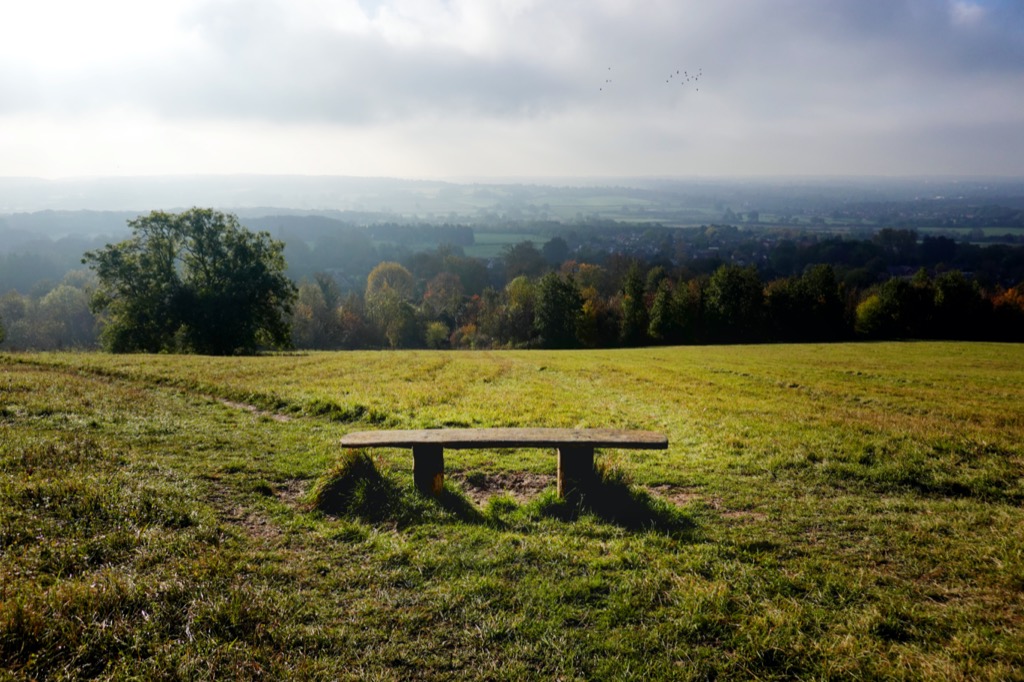
We have entered the period known in Gaelic as the ‘darker-half of the year’. Samhain is a pagan religious festival originating from an ancient Celtic spiritual tradition. In modern times, Samhain (a Gaelic word pronounced “SAH-win”) is usually celebrated from October 31 to November 1 to welcome in the harvest and usher in “the dark half of the year.” Celebrants believe that the barriers between the physical world and the spirit world break down during Samhain, allowing more interaction between humans and denizens of the Otherworld. Ancient Celts marked Samhain as the most significant of the four quarterly fire festivals, taking place at the midpoint between the fall equinox and the winter solstice. During this time of year, hearth fires in family homes were left to burn out while the harvest was gathered.
After the harvest work was complete, celebrants joined with Druid priests to light a community fire using a wheel that would cause friction and spark flames. The wheel was considered a representation of the sun and used along with prayers. Cattle were sacrificed, and participants took a flame from the communal bonfire back to their home to relight the hearth.
Early texts present Samhain as a mandatory celebration lasting three days and three nights where the community was required to show themselves to local kings or chieftains. Failure to participate was believed to result in punishment from the gods, usually illness or death.
Some documents mention six days of drinking alcohol to excess, typically mead or beer, along with gluttonous feasts. As the Middle Ages progressed, so did the celebrations of the fire festivals. Bonfires known as Samghnagans, which were more personal Samhain fires nearer the farms, became a tradition, purportedly to protect families from fairies and witches. Carved turnips called Jack-o-lanterns began to appear, attached by strings to sticks and embedded with coal. Later Irish tradition switched to pumpkins. In Wales, men tossed burning wood at each other in violent games and set off fireworks. In Northern England, men paraded with noisemakers.
As Christianity gained a foothold in pagan communities, church leaders attempted to reframe Samhain as a Christian celebration.
The first attempt was by Pope Boniface in the 5th century. He moved the celebration to May 13 and specified it as a day celebrating saints and martyrs. The fire festivals of October and November, however, did not end with this decree.
In the 9th century, Pope Gregory moved the celebration back to the time of the fire festivals, but declared it All Saints’ Day, on November 1. All Souls’ Day would follow on November 2.
Neither new holiday did away with the pagan aspects of the celebration. October 31 became known as All Hallows Eve, or Halloween, and contained much of the traditional pagan practices before being adopted in 19th-century America through Irish immigrants bringing their traditions across the ocean.
Trick-or-treating is said to have been derived from ancient Irish and Scottish practices in the nights leading up to Samhain.
It was a bright morning, with warm sunshine and a cold breeze. It is, perhaps, that day defined in The Meaning of Liff as ‘Brithdir – The first day of the winter on which your breath condenses in the air.’ I climbed a steep grassy hillside to enjoy the misty, pale view southwards over miles of woodland and villages. I sat on a bench and poured a cup of coffee from my flask. A plaque on the bench commemorated an old man ‘who lived in this village and found peace in these hills.’ Pinned to the fence was a photograph of a young man who died aged just 21. I Googled his name, but unusually could find no online information about him. This is so unusual these days. Indeed the very searchability of everything has given so much to this Single Map project. I have learned much by wandering around my map. But I have also discovered so many things that interest me through the Googling prompted by each outing. I have gleaned much more from the experience by following my curiosity around the internet.
The hillside to my right was totally covered in trees, except for one large open field that had at some point been cleared from the wood, like a bald patch of buzzcut on someone’s scalp. At this time of year the woodland is a beautiful mosaic of green leaves, autumn colours, bare branches, and dark evergreen trees.

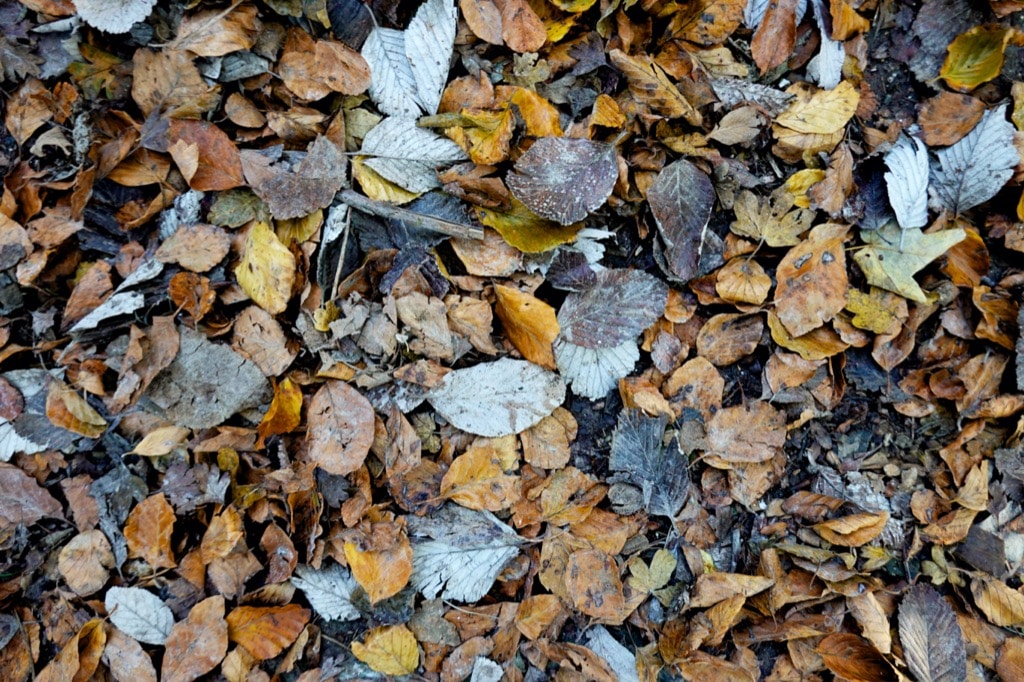
During spring and summer, chlorophyll helps plants with the process of photosynthesis. This turns carbon dioxide, water and the light from the sun into sugars that feed a tree. The green from chlorophyll masks other colours throughout the sunnier months. Then, as nights start to grow longer and less sunlight is available, this signals to trees that autumn is on the way. The production of chlorophyll slows and then stops completely. This is when the golden hues we love start to appear.
A group of chemicals called carotenoids are always found in leaves. These help protect plants from sun damage. Once chlorophyll’s dominant green is reduced, fiery oranges become much bolder. Xanthophyll, a type of carotenoid, is responsible for the yellow colours we see in plants. This sticks around long after the chlorophyll has disappeared.
Golden orange hues also come from carotenoids. These pigments start disappearing at the same time as chlorophyll does, but at a much slower rate, so their colours last well into autumn. Beta carotene is a type of carotenoid, and is responsible for giving plants and many edible goodies their orange colouring. You can find it in foods such as sweet potato, carrots and apricots.
While all trees have chlorophyll and carotenoids, not all produce anthocyanin, the pigment that causes leaves to turn red. Anthocyanin is only found during part of a tree’s growing season, and is produced from sugars trapped in leaves as the tree prepares to shed them. You’re more likely to see brighter reds in a year where spring and summer have been warmer, drier and sunny.
I was enjoying the peace of this beautiful fresh autumn morning when a dog sprinted at me yapping and snarling. I like dogs, and they generally don’t scare me. But I’m also not one of those gushing dog lovers who use that loud, simplified voice people save for pets or toddlers. Whilst Fido snarled and snapped at me the owner made no attempt to put it on a lead. She gave me a large happy smile and spoke to her dog.
“You won’t bite the man, will you? You’re just saying hello aren’t you?”
Then, to me, with a big smile. “Stand absolutely motionless and you’ll be absolutely fine.”
To the dog. “If the man wants to wear a rucksack and a woolly hat then he can. Don’t be noisy just because you don’t like men like that.”
To me, with a big smile. “He doesn’t like men with hats on.”
The man with a hat was by now quite tempted to kick the yappy mongrel but instead settled for making his way up the hill and into the woods.
The floor of the wood was covered in a golden carpet of leaves and thousands of beech nuts lay beneath each tree. One giant of a tree had heavy straps tied between its two primary branches to help prevent the top-heavy tree splitting asunder in heavy winds. I crunched my way up through the woods to the open hilltop which offered wonderful views across the still-misty landscape, though up here the sun was bright. I passed a large cross and two horses – one grumpy, one friendly. The friendly horse was adamant that I should give him a good long stroke before continuing. A bench on top of the hill had something I have never seen before; a solar-powered speaker which gave you information about the local area when you pressed the button. A bunch of lost keys hung on the fence, a beam of sunshine shone all the way through the gnarled trunk of a hollow ash tree, and a white passenger jet flew high overhead in the flawless blue sky. I used to fly often, and far, and I enjoyed it very much. But I have not been on a plane now for a couple of years or more. I miss the excitement and the variety and the surprise of fast foreign travel. But I miss it less than I thought that I would. I miss it less the more time goes by. And I certainly miss it less when I pour myself into the astonishing richness of exploring a single map.




Very much enjoying the magnificent views from this hilltop is a grand old manor house, now a venue for Christian conferences and retreats. It was signed as Private so I couldn’t explore the old building. A noticeboard on the outer wall offered ‘Evidence for the Resurrection’ so I made do with reading that instead.
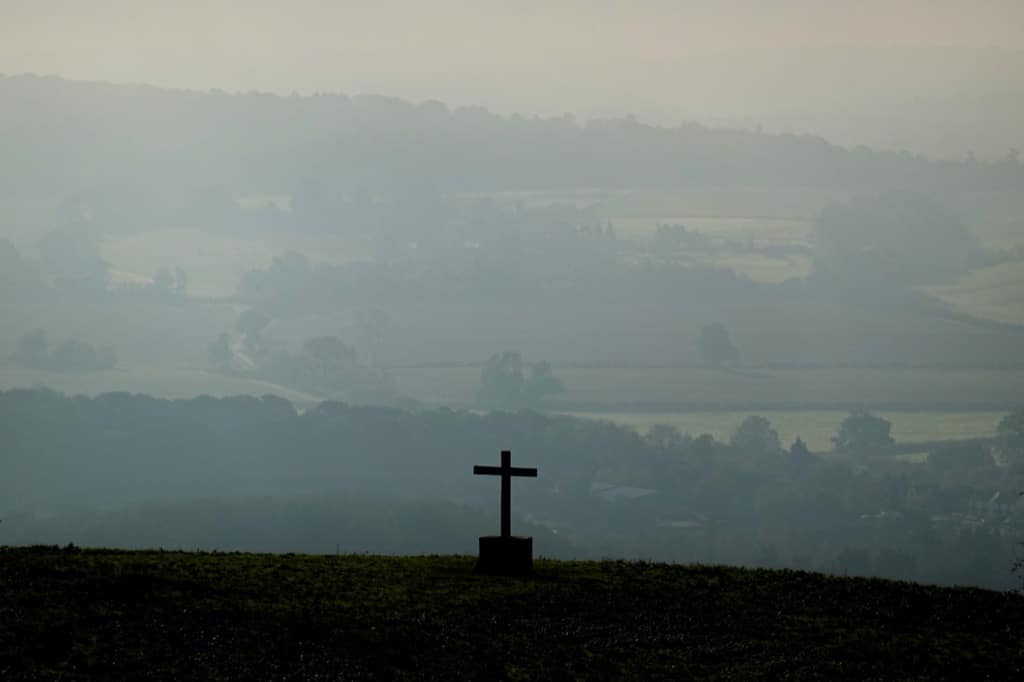
Behind the manor house the land flattened out into an area of large open grassy fields dotted with oak trees. I followed a footpath across them towards some woods. The paths are slowly becoming slippery and muddy again as winter approaches. A green woodpecker flew between two trees, and a cluster of pigeons flapped noisily up from the ground then flew swiftly out of sight. I smiled to myself. All year I have been seeing pigeons – on literally every grid square I have explored – and yet have never bothered to write about them. I have grown very fond of birds and fit it satisfying to watch them, listen to them and allow them to help me become more observant. But pigeons do not interest me at all. I presume this is due to their lack of mystery (they are everywhere, they are obvious), their lack of beauty (their dumb cooing of “my toe hurts, Betty” over and over, their clattering inelegant take off, their scruffy nests of twigs), and my dislike for their tough urban cousins the feral pigeon who flaps and struts and poos in such numbers.
Yet this dismissive discrimination is not at all in keeping with this project, which has urged me to look for the beauty and interest in every corner of my map. And a couple of years ago I read a surprisingly interesting book about homing pigeons called Homing: On Pigeons, Dwellings and Why We Return.
As a boy, Jon Day was fascinated by pigeons, which he used to rescue from the streets of London. Twenty years later he moved away from the city centre to the suburbs to start a family. But in moving house, he began to lose a sense of what it meant to feel at home. Returning to his childhood obsession with the birds, he built a coop in his garden and joined a local pigeon racing club. Over the next few years, as he made a home with his young family in Leyton, he learned to train and race his pigeons, hoping that they might teach him to feel homed.
Having lived closely with humans for tens of thousands of years, pigeons have become powerful symbols of peace and domesticity. But they are also much-maligned, and nowadays most people think of these birds, if they do so at all, as vermin. A book about the overlooked beauty of this species, and about what it means to dwell, Homing delves into the curious world of pigeon fancying, explores the scientific mysteries of animal homing, and traces the cultural, political and philosophical meanings of home. It is a book about the making of home and making for home: a book about why we return.
One thing about the internet is that you can find supporters of anything you choose. So I turn to a fan of the wood pigeon to help me counter my prejudice. He points out that my indifference overlooks the wonderful contributions made by wood pigeons. I love the coarse throaty song, with its characteristic five-note motif, that’s so much the background music to British woods. I love too those strange mock battles performed by males, when they strike each other with open wings and fill the treetop with the noise of their hollow bluster. I love most of all those moments in midwinter when they can seem sublimely beautiful – the flock coming down on to a field and the broken silver arc of their underwings turned purer than white by reflected snow.
These experiences should force us at least to recall that the wood pigeon can not be blamed for the darker symbolism it has recently acquired. Since the 1960s the population has increased by 170%. The species’ catholicity in food and habitat, as well as its wider adaptations to humans, means that it thrives in our massively simplified countryside, where so many others birds now fail.
Wood pigeons go on increasing and while we may not notice their abundance, visiting friends from Africa or Spain are alert to a countryside, which to them, seems full of nothing but wood pigeons. It has become less an expression of abundance as an emblem of loss. Today pigeons represent a biomass not much less than that of all the songbirds in Britain.
The fields were still damp with dew, despite the surprising warmth from the November sun. When I turned to face the sun the field sparkled with a million diamond dew drops. In times gone by the ephemeral beauty of these shining droplets, each with an upside down image of the world hanging within it, led to much folklore. For example, the dew on 1 May has magical properties and anyone who washes their face in it will have a flawless complexion for the entire year. May dew was also said to be able to remove spots, freckles and pimples.

This country belief was widely accepted by city folk, as famously recorded by diarist Samuel Pepys. He noted that his wife went to Woolwich on the night of 30 April 1667 to collect May dew the following morning “which Mrs Turner hath taught her is the only thing in the world to wash her face with.”
A traditional rhyme says that the maid who rises early on May morning “And washes in dew from the hawthorn tree,/ Will ever after handsome be.” Others suggest that the dew had to be collected from ivy leaves, or from grass under oak trees. The one factor universally agreed upon is that the dew is only effectual at or just before sunrise.
The best way to be sure of catching the early dew was to stay out all night in the woods or meadows – though some might suspect other motives for such an adventure. In 1583, puritan Philip Stubbes recorded that of the girls who spent the May Day eve in the woods, “scarcely the third part of them returned home again undefiled.” The modern obsessions with appearance and young people’s sexual behaviour go back quite some way.

I made my way into a small wood where I found a giant of a beech tree, hundreds of years old and enormous. The huge circle of bare ground at its base gave an idea of the size of its canopy and how effectively it filtered out the sunlight, eliminating the competition of any young upstarts below. A frayed rope hung from one branch, the relic of a former rope swing at some time or another. Nailed to the tree, about 10 feet off the ground was a simple, small plaque saying ‘Peter 1925 – 2009’. How little we will know of Peter’s 84 years once the memories have faded of whoever fixed that plaque. A large old tree on a sunny morning is a fine reminder of one’s place in the order of things and how wise it is to savour today rather than worrying about such intangibles as our legacy. Perhaps the best legacy we can all leave behind is to plant trees whose great shade we know we shall never sit beneath.
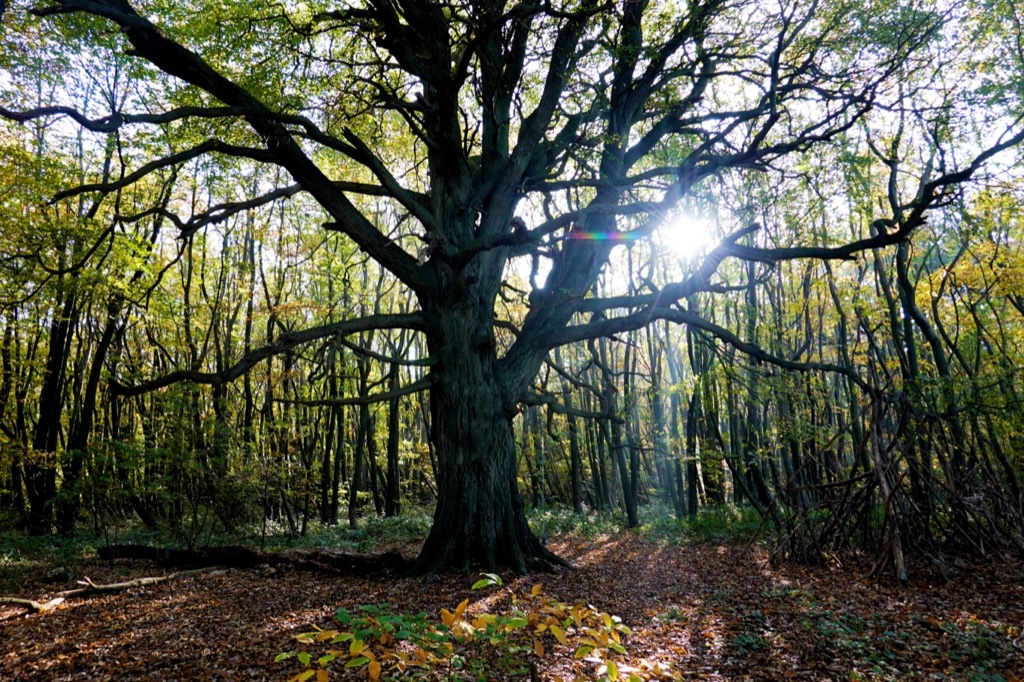
Or, perhaps, I might settle for the legacy of ‘our Fred’ whose 60 years of life were remembered on a lovely carved wooden bench in those woods along with the note that ‘you loved to walk through these woods on your way to the pub for a glass of lunch’.
That, plus some trees, would do me very well indeed.
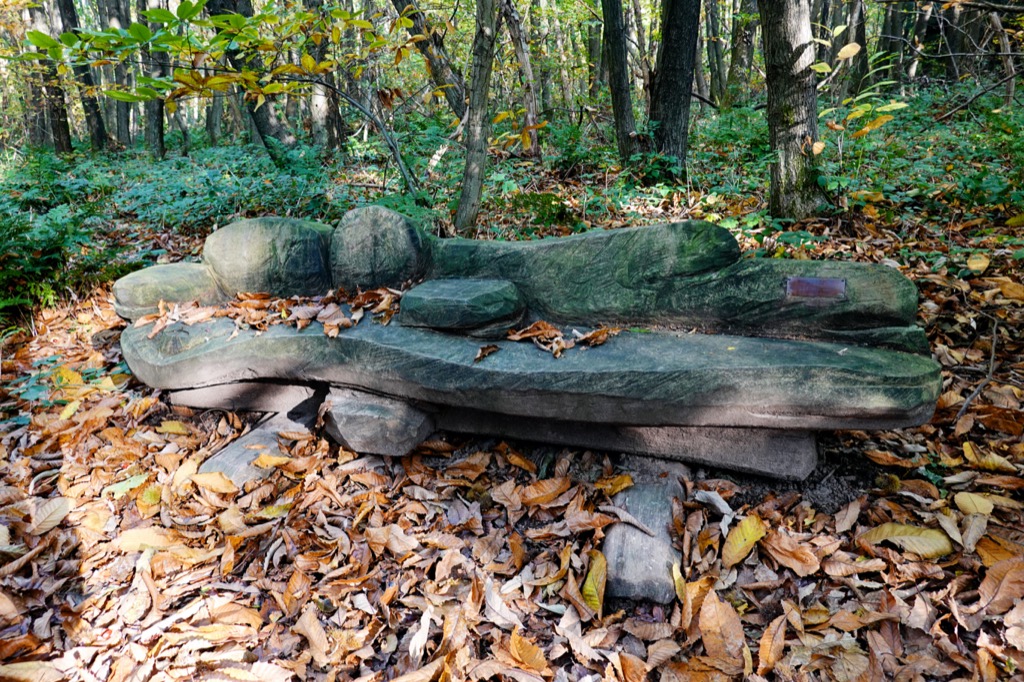



Comments